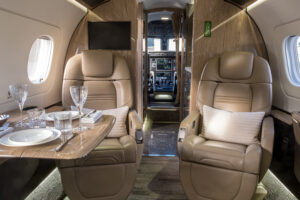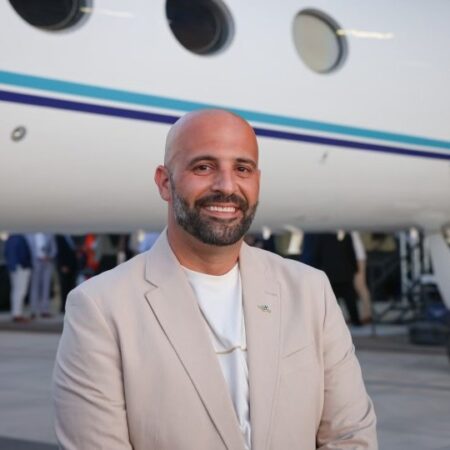In 2023 many private aviation fleet operators felt a post-Covid slowdown. To ensure that this year sees growth and is profitable, they are exploring ways to attract new customers. VistaJet, for example, believes its membership-driven business models have permitted it to attract new sales and growth. While customers were driven away from airlines, some of them chose to fly with private aviation – leading to a growth spurt in the industry.
However, like in most other industrial sectors, business aviation was also affected by supply chain constraints and increased competition from new entrants to the market. Despite this challenge, VistaJet’s approach has helped it to realize a 74% growth in committed program hours since Q3 2022. Its flight hours in the Middle East have also risen by 22%.
Nikhil Kilpady, a director in Frost & Sullivan’s aerospace and defense practice, says the main business models that business aviation charter companies continue to adopt include: on-demand charter; fractional ownership – an example of which is Flexjet, although it stresses that it is not a charter provider); jet card initiatives – pre-paid flying hours or a certain sum of money for charter services; membership – which operates in a similar way to jet cards, but with some differences such as priority booking for members and discounts in return for paying an annual fee; management contracts where charter businesses manage and fly private aircraft on behalf of their owners, providing aircraft management and charter services; leasing, which involves clients of charter firms may renting aircraft for extended periods of time; and then there is a hybrid approach that involves a combination of the above business models.
Business model transformation
For 30 years there was a single business model, which involved a chart. A client would call to obtain a quote and then decide which company to go with before booking. The arrangement was a pay as you go one. NetJet then entered the market with a fractional ownership model, which gave customers a share in an aircraft. However, this meant the client had to commit large amounts of money up front. The offering then evolved into a jet card program, where clients instead pay for around 50 hours of aircraft use upfront. This was reduced to 25 when the company needed to attract more customers.
In the industry, there is also an ad hoc charter or block program, which brought many new clients into the private jet world and has benefited not just NetJets but many other operators. NetJet’s large marketing budget worked to spread the word amongst businesses and high net worth individuals and had an overall positive effect promoting the industry.
As for the jet card, the principle is guaranteed aircraft availability within – with some operators – 24 hours of notice. The person or company chartering the aircraft only pays for an occupied flight. This comes at a much higher hourly charter rate than ad-hoc charters do. This suits people who predominantly fly one way, returning days or weeks later.
For example, if a client wants to fly from Marrakesh to Nice, one way, using ad-hoc charter, that may mean an aircraft would have to re-position to Marrakesh and then return to its base after the drop-off in Nice. This makes the trip more expensive than using a jet card and paying a higher hourly rate, but only being charged for the Marrakesh to Nice sector.
The decision to buy either a jet card membership or to charter ad hoc very much depends on the client’s flying profile. The ability to hire aircraft also depends on their availability. Busy periods such as during school vacation dates or when large sporting events such as the Grand Prix are happening, may also be decisive factors for a client to consider. While ad-hoc charter does not guarantee availability, planning and using an operator with a large and diverse fleet or a good charter broker should help to overcome this issue.
These different operating models will vary based on several factors. These include the size of the fleet, whether the aircraft operate in a particular region or globally, if they target high net worth individuals, or if they operate in specialized niches.
Large fleets, for example, concentrate on economies of scale, “providing a broad variety of aircraft sizes and kinds to meet the varied needs of their clientele,” says Kilpady. He comments that their size is appropriate for on-demand charter services, which “provide a wider range of customers flexibility and availability.”
Then you have those that have a global presence, giving them the ability to provide long-range and international services. Global operations target clients who need private transportation across continents, and they often operate using a jet card or fractional ownership business model. That’s because they are significantly favored by clients who require flexibility while traveling longer distances. In comparison, corporate clients are likely to opt for a membership model that offers a range of perks and jet card programmes that are designed to meet their demands.
Jet leasing or fractional ownership
Kilpady explains that high net worth individuals tend to go for jet leasing or fractional ownership and that they often require specialized services, unique encounters, and access to opulent airplanes. Then you have clients from or with an interest in specialized niches. They concentrate on particular sectors of the economy. These niches include sports teams, a combination of target customer types, Meetings, Incentives, Conferences and Exhibitions (MICE events), or ambulance services. These operators can modify their business plans to accommodate the requirements and tastes of their niche market.
He therefore stresses that a combination of the target customer, geographic location, and fleet size affects charter business models. Other factors include personalized services, ease of use and flexibility when customizing these models to satisfy the specific requirements of the private aviation sector.
Jet card programs
“The jet card programs have been around for at least 20 years. Are they profitable? I have my doubts, and that’s why we decided to not go into it. If you were to ask a jet card program for a flight from Casablanca to Cairo, the costs are quite considerable, and so they would certainly be done at a loss. For an ad hoc charter, the client must pay for the occupied and non-occupied sectors,” says George Galanopoulos, CEO of Luxaviation UK.
Regarding how operators differentiate themselves from each other, he suggests that the customer experience should be the same whoever a client choose to fly with privately. He underlines that it should always be excellent. However, he claims that the more established players such as his own company, Luxaviation, can offer an extra level of customer service. Beyond this though is the need to know that flying with a private aviation operator is safe.
“Safety is of paramount importance. Beyond that, all well-established operators will offer an excellent service. The catering or the crew for example might differ – it varies from company to company. From the customer’s perspective, as long as the aircraft is fairly new or newly refurbished, they should always get an excellent service. A newcomer to the industry may not have the resources or the experience to add that extra offering.”
New and emerging markets

Differentiation can also be achieved through expansion into new and emerging markets. Kilpady finds that charter businesses are exploring the potential of entering previously unexplored areas – including emerging economies such as Saudi Arabia. “Business and leisure travel are expanding here, and there is a growing demand for private jet charters.” Shifting consumer tastes and market conditions are driving a dynamic transition in the private jet charter sector.
This may also include, says Galanopoulos, a shift towards more eVTOLs, and aircraft powered by hydrogen population. eVTOLs are a cross an electrified helicopter and a fixed-wing aircraft. They are being developed by several companies. Certification for them will be the main challenge, and there is a need for more infrastructure for them. They also require a heliport where they can land which is equipped with appropriate charging facilities.
The biggest challenge is endurance because at the moment they can fly 200 miles on a charge, so they are mostly focused on serving cities within a country or for shorter distances. Yet there range is bound to increase.
Technology can be a way for charter companies to differentiate themselves too.
“AI is becoming more part of our lives, and this will optimize the flight routes even further, saving time and fuel, enhancing sustainability. You can use it to decide optimal flight levels and distances, providing financial savings and reducing fuel burn,” says Galanopoulos.
“From the business model, especially with a Jet Card model, technology is being improved to find the nearest aircraft.
“You can use the technology to identify the closest aircraft that can do an actual charter. You need to know where the aircraft and crew are. This can optimize bookings and flights.”
So, in 2024, the keys to success are financial viability, a willingness to embrace innovation and change, and flexibility. There is also an opportunity to embrace growth by opening up the market to people who usually can’t afford private jets, and by considering or even creating new business models.
This is a big challenge, but charter businesses need fresh ideas to increase growth.






